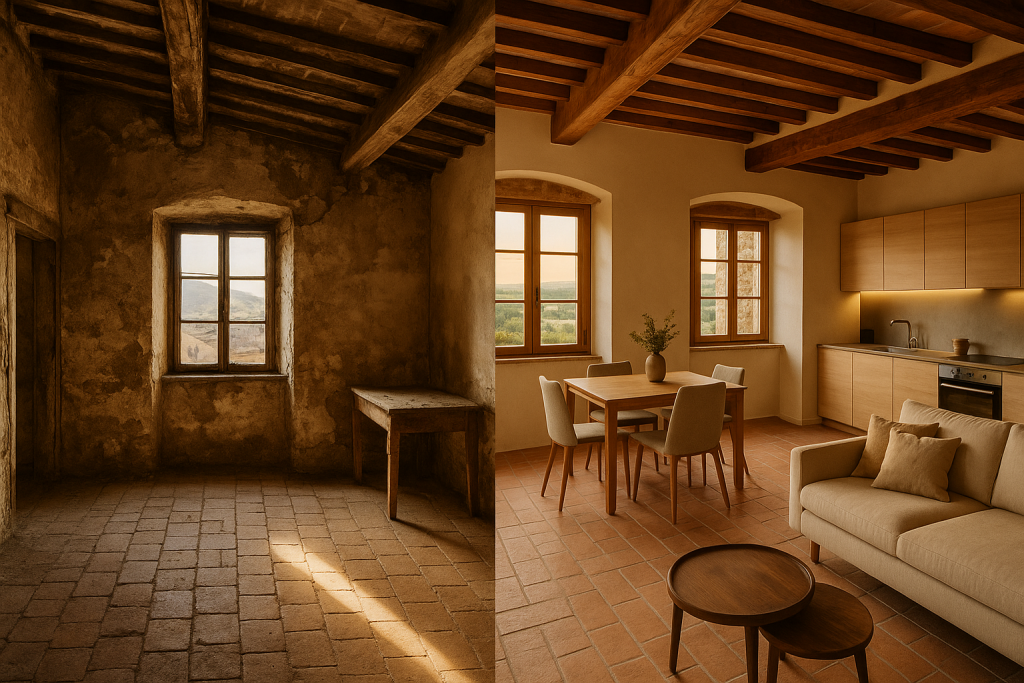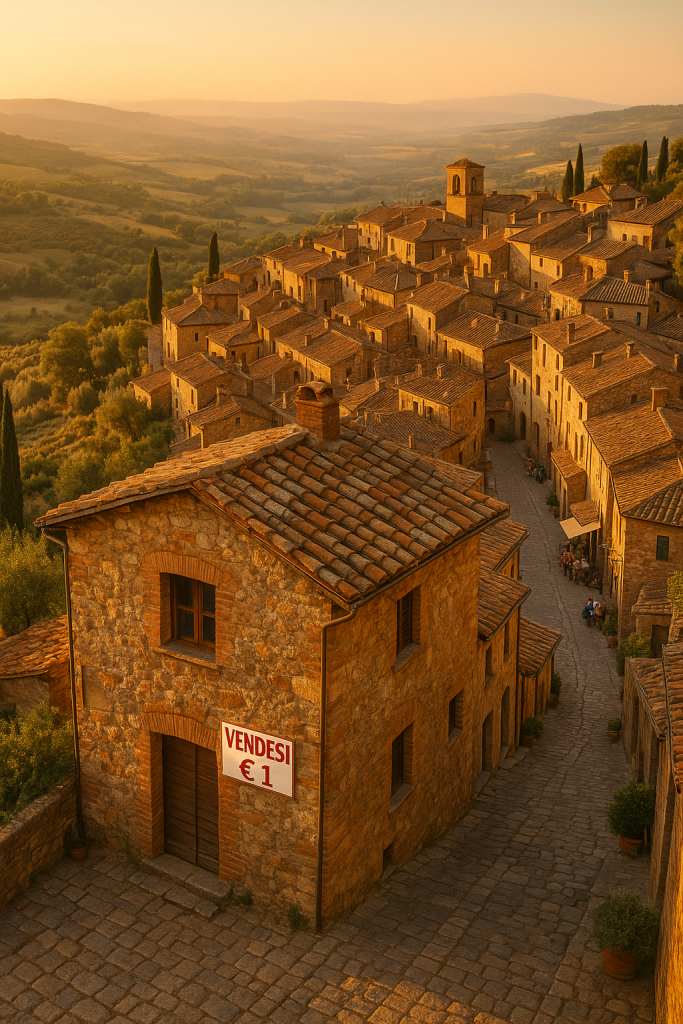How a symbolic price tag is offering sophisticated investors the ultimate lifestyle transformation
The morning sun casts honey-coloured shadows across the cobblestones of Sambuca di Sicilia, where weathered stone houses cascade down narrow streets like a Renaissance painting come to life. Here, amid the scent of wild fennel and the distant sound of church bells, a small wooden sign catches the eye: “Vendesi €1.” For sale: one euro. It’s a scene that has captivated international attention and sparked a revolution in lifestyle investment, transforming how the global elite think about property, purpose, and the pursuit of authentic living.
Welcome to Italy’s most compelling real estate phenomenon—a program that’s not merely about affordable housing, but about curating a life of meaning in some of Europe’s most enchanting forgotten corners. Many rural Italian towns are offering properties for the equivalent of $1 in an effort to revitalise their communities. What began as a desperate measure to combat rural depopulation has evolved into something far more sophisticated: an opportunity for discerning individuals to become custodians of Italian heritage while crafting their own version of la dolce vita.
The Renaissance of Rural Italy
 From Sicily to Puglia, through Sardinia and Tuscany, the one-euro homes project allows you to purchase a property for a symbolic price, with the program seeing success in towns like Salemi (Sicily), and its appeal growing across the country, with municipalities from Abruzzo to Puglia jumping on board. The numbers tell a remarkable story: as of 2025, more than 30 municipalities in the northern province of Trentino are offering significant financial incentives to attract new residents.
From Sicily to Puglia, through Sardinia and Tuscany, the one-euro homes project allows you to purchase a property for a symbolic price, with the program seeing success in towns like Salemi (Sicily), and its appeal growing across the country, with municipalities from Abruzzo to Puglia jumping on board. The numbers tell a remarkable story: as of 2025, more than 30 municipalities in the northern province of Trentino are offering significant financial incentives to attract new residents.
The movement has gained particular momentum in Sicily, where one-euro home selloffs typically get snapped up very quickly, but local siblings Antonino and Carmelo Cuschera have dedicated themselves to hunting down more properties for eager bargain hunters. Villages like Gangi, Mussomeli, Sambuca di Sicilia, Caltagirone, and Troina have joined in, with Sicily’s offerings being particularly attractive because even inland villages aren’t far from the sea.
But perhaps most intriguingly, Penne, a picturesque village in the province of Pescara, has been part of the prestigious “Most Beautiful Villages in Italy” network since 2012. This isn’t about acquiring derelict properties in forgotten places—these are UNESCO-worthy settings where history whispers from every stone archway.
The Real Investment: Beyond the Symbolic Euro
The sophisticated investor understands that the true cost lies not in the purchase price, but in the transformation journey. Recent case studies show renovation budgets starting at $20,000, with one buyer setting an initial budget of $20,000 and spending $35,000 on expenses including a new kitchen, marble finishes, restored stone walls and a fireplace in the bathroom. For a total investment of under $40,000, this represents extraordinary value in today’s global property market.
However, the spectrum varies dramatically. One American buyer spent $446,000 renovating her 1-euro home over four years, finding that her journey gave her a new perspective on work, life, friendships and happiness. The investment isn’t merely financial—it’s existential, offering what money can’t typically buy: authentic cultural immersion and the satisfaction of preserving architectural heritage.
Some programs offer renovation costs starting around €20,000 for small to medium houses, with over 40 vacant buildings available in historic centres. The key lies in understanding that these aren’t traditional real estate transactions, but collaborations with communities eager to share their cultural legacy with committed newcomers.
The New Nomadic Aristocracy
The post-pandemic era has created a new class of location-independent professionals who view property acquisition through a radically different lens. Remote work capabilities have made previously impractical lifestyle choices suddenly viable, and Italy’s one-euro houses represent the intersection of wanderlust and smart investment.
These aren’t impulse purchases for weekend retreats—they’re strategic lifestyle moves for individuals seeking authentic cultural experiences. The buyers range from tech entrepreneurs establishing European bases to artists seeking inspiration in centuries-old studios, from writers craving the creative energy of Italian village life to retirees pursuing their Mediterranean dreams with sophisticated planning.
The appeal transcends mere property acquisition. It’s about joining a renaissance of rural Italian life, where newcomers become part of preservation efforts that benefit both the community and the investor. Village mayors speak of transformation not just in population numbers, but in the energy and innovation that international residents bring to local economies.
Navigating the Cultural Investment
Success in Italy’s one-euro market requires more than financial resources—it demands cultural sensitivity and long-term commitment. The most successful buyers approach their investment as cultural stewardship, understanding that they’re not merely renovating buildings but participating in community revival.
Legal requirements vary by municipality, but typically include commitments to complete renovations within specific timeframes (usually 2-3 years) and maintain the property as either a primary or secondary residence. Some programs require buyers to establish local residency, while others welcome vacation home owners who contribute to the local economy.
The renovation process itself becomes a cultural education. Working with local craftsmen, navigating Italian bureaucracy, and sourcing traditional materials connects buyers to centuries-old building traditions. Many describe the experience as transformative, offering insights into Italian culture that no tourist experience could provide.
The Ripple Effect: Community and Economy
These investments create positive economic ripples throughout rural communities. Local contractors, architects, and artisans benefit from renovation projects, while new residents support restaurants, shops, and services. The cultural exchange proves mutually beneficial—international buyers bring global perspectives and often establish businesses that create employment opportunities.
Villages report increased tourism as beautifully renovated properties attract visitors curious about the one-euro phenomenon. This attention brings additional economic benefits while raising the profile of previously overlooked destinations. The program’s success has inspired similar initiatives across Europe, cementing Italy’s position as a pioneer in creative rural development.
The Sophisticated Buyer’s Approach
For discerning investors, due diligence extends beyond property inspection to cultural research. Understanding local traditions, learning basic Italian, and establishing relationships with community leaders prove as valuable as architectural surveys. The most successful buyers approach their investment holistically, viewing renovation costs as cultural education expenses and community integration as part of the property’s value proposition.
Smart buyers also recognise the long-term appreciation potential. As these villages gain international attention and infrastructure improves, property values in successfully revitalised communities show significant growth. Early investors in now-popular villages like Salemi have seen dramatic value increases alongside their lifestyle benefits.
La Dolce Investment
Italy’s one-euro houses represent more than real estate opportunity—they offer entry into a lifestyle that prioritises authenticity over ostentation, community over isolation, and cultural richness over material accumulation. For sophisticated investors seeking meaningful engagement with their assets, these properties provide unparalleled returns measured not just in euros, but in life satisfaction.
The program continues expanding, with new municipalities joining regularly and existing participants refining their offerings. As remote work normalises and travel restrictions ease, demand for these unique lifestyle investments will likely intensify. For those ready to embrace la dolce vita with both passion and pragmatism, Italy’s one-euro houses offer an extraordinary opportunity to invest in both property and personal transformation.
The morning light in Sambuca di Sicilia reveals not just ancient stones and weathered doors, but possibilities—for community, for creativity, for a life lived with intention. For one euro, Italy offers not just a house, but a home in the truest sense: a place where life’s richest experiences await those bold enough to claim them.


